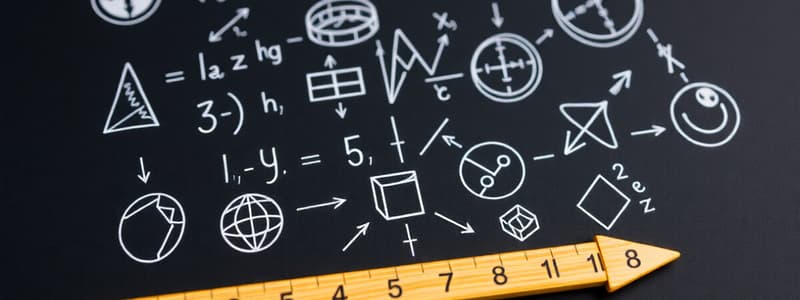Podcast
Questions and Answers
Which branch of mathematics focuses on the study of shapes, sizes, and properties of space?
Which branch of mathematics focuses on the study of shapes, sizes, and properties of space?
- Algebra
- Geometry (correct)
- Calculus
- Statistics
What does the Fundamental Theorem of Calculus establish?
What does the Fundamental Theorem of Calculus establish?
- Differentiation and integration are inverse processes. (correct)
- The area under a curve can be calculated without integration.
- All polynomials are factorable.
- Every polynomial equation has a real root.
If a right triangle has legs of length 3 and 4, what is the length of the hypotenuse using the Pythagorean Theorem?
If a right triangle has legs of length 3 and 4, what is the length of the hypotenuse using the Pythagorean Theorem?
- 6
- 8
- 5 (correct)
- 7
Which of the following mathematical symbols represents the concept of change or difference in a quantity?
Which of the following mathematical symbols represents the concept of change or difference in a quantity?
What operation is performed first according to the order of operations in PEMDAS?
What operation is performed first according to the order of operations in PEMDAS?
Which of the following statements about probability is true?
Which of the following statements about probability is true?
What is the approximate value of the mathematical constant π (Pi)?
What is the approximate value of the mathematical constant π (Pi)?
Which branch of mathematics is primarily concerned with the collection, analysis, interpretation, and presentation of data?
Which branch of mathematics is primarily concerned with the collection, analysis, interpretation, and presentation of data?
Flashcards are hidden until you start studying
Study Notes
Key Concepts in Mathematics
1. Branches of Mathematics
- Arithmetic: Basic operations (addition, subtraction, multiplication, division).
- Algebra: Use of symbols and letters to represent numbers in equations.
- Geometry: Study of shapes, sizes, and properties of space.
- Trigonometry: Relationships between angles and sides in triangles.
- Calculus: Study of change, involves differentiation and integration.
- Statistics: Collection, analysis, interpretation, and presentation of data.
- Probability: Study of randomness and uncertainty; likelihood of events.
2. Fundamental Theorems
- Pythagorean Theorem: In a right triangle, ( a^2 + b^2 = c^2 ) (where c is the hypotenuse).
- Fundamental Theorem of Algebra: Every non-constant polynomial equation has at least one complex root.
- Fundamental Theorem of Calculus: Links differentiation and integration; states that differentiation and integration are inverse processes.
3. Mathematical Operations
- Order of Operations: Remember PEMDAS (Parentheses, Exponents, Multiplication and Division, Addition and Subtraction).
- Factoring: Breaking down expressions into multiplied components (e.g., ( x^2 - 9 = (x-3)(x+3) )).
- Solving Equations: Techniques include isolating variables, using inverse operations, and applying the quadratic formula.
4. Graphing
- Coordinate System: Cartesian plane defined by x (horizontal) and y (vertical) axes.
- Linear Equations: Represented as ( y = mx + b ); where m is the slope and b is the y-intercept.
- Functions: Relation between input (x) and output (y); notation ( f(x) ).
5. Mathematical Symbols
- (\infty): Infinity.
- (\sum): Summation.
- (\sqrt{}): Square root.
- (\Delta): Change or difference in a quantity.
- (\forall): For all (universal quantifier).
- (\exists): There exists (existential quantifier).
6. Applications of Mathematics
- Real-world Problems: Used in fields like physics, engineering, economics, and social sciences.
- Data Analysis: Essential for interpreting statistical data, trends, and patterns.
- Cryptography: Mathematics is foundational for secure communication and data protection.
7. Important Mathematical Constants
- π (Pi): Approx. 3.14; ratio of the circumference of a circle to its diameter.
- e: Approx. 2.718; base of natural logarithms, important in calculus.
Study Tips
- Practice regularly to reinforce understanding.
- Utilize visual aids (graphs, diagrams) for complex concepts.
- Solve a variety of problems to gain a deeper understanding.
- Collaborate with others for different perspectives and solutions.
Branches of Mathematics
- Arithmetic: Involves fundamental operations such as addition, subtraction, multiplication, and division.
- Algebra: Manipulates symbols and letters to formulate and solve equations.
- Geometry: Explores the properties, dimensions, and relationships of shapes and space.
- Trigonometry: Analyzes the connections between the angles and sides of triangles.
- Calculus: Investigates rates of change through differentiation and the accumulation of quantities via integration.
- Statistics: Concerned with the systematic collection, analysis, interpretation, and presentation of numerical data.
- Probability: Studies the likelihood and uncertainty of events occurring in random situations.
Fundamental Theorems
- Pythagorean Theorem: Expresses that in a right triangle, the square of the hypotenuse equals the sum of the squares of the other two sides (( a^2 + b^2 = c^2 )).
- Fundamental Theorem of Algebra: Guarantees that every non-constant polynomial equation has at least one complex root.
- Fundamental Theorem of Calculus: Establishes the relationship between differentiation and integration, indicating they are inverse processes.
Mathematical Operations
- Order of Operations: Follow PEMDAS to solve mathematical expressions (Parentheses, Exponents, Multiplication and Division, Addition and Subtraction).
- Factoring: Involves the process of breaking down expressions into their multiplicative components (e.g., ( x^2 - 9 = (x-3)(x+3) )).
- Solving Equations: Involves techniques like isolating variables, applying inverse operations, and utilizing the quadratic formula.
Graphing
- Coordinate System: Defined by the Cartesian plane where horizontal (x-axis) and vertical (y-axis) axes intersect.
- Linear Equations: Generally represented in the form ( y = mx + b ), where m represents the slope and b the y-intercept.
- Functions: Describe a relationship between an input (x) and an output (y) using the notation ( f(x) ).
Mathematical Symbols
- (\infty): Represents the concept of infinity.
- (\sum): Symbol for summation, indicating the addition of a series of numbers.
- (\sqrt{}): Denotes the square root of a number.
- (\Delta): Indicates a change or difference in a given quantity.
- (\forall): Denotes "for all," used as a universal quantifier.
- (\exists): Means "there exists," serving as an existential quantifier.
Applications of Mathematics
- Real-world Problems: Mathematics is critical in diverse fields, including physics, engineering, economics, and social sciences.
- Data Analysis: Vital for interpreting statistical data, recognizing trends, and understanding patterns.
- Cryptography: Forms the backbone of secure communication and data protection techniques.
Important Mathematical Constants
- π (Pi): Approximately 3.14, representing the ratio of a circle's circumference to its diameter.
- e: Approximately 2.718, the base of natural logarithms, essential in calculus and growth calculations.
Study Tips
- Practice regularly to enhance comprehension and retention of concepts.
- Use visual aids like graphs and diagrams to simplify complex ideas.
- Tackle a diverse range of problems to deepen understanding and application of concepts.
- Collaborate with peers for varied perspectives and solutions to mathematical challenges.
Studying That Suits You
Use AI to generate personalized quizzes and flashcards to suit your learning preferences.




